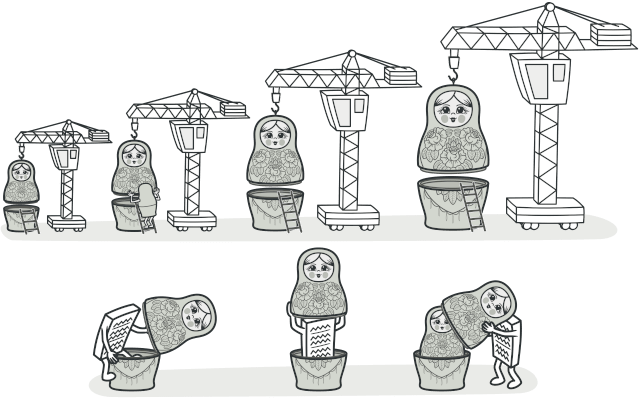Intents
Suppose I just bought a brand new house, before I move in, I need to decorate the house with furnitures, appliances, etc. Take the bed for example, we need consider bed frame, bed mattress, bed sheet, pillows, etc. Now consider that you are create a new software which helps customers to simplify the move-in decoration process. You might wanna use inheroitance to solve this problem. For example:
public abstract class Bed {
String material;
String getMaterial();
int getSize();
}
public class WoodenKingBed extends Bed {
String material = "Wood";
String getMaterial();
int getSize();
}
public class MetalQueenBed extends Bed {
String material = "Metal";
String getMaterial();
int getSize();
}
// ...
For the above example, it seems ok considering the size of the bed and material for bed frame is pretty limited. However, consider another similar problem, which is the base class is beverage and the inheritance we can have lots of different drinks that extend the base beverage class. This will lead to the explosion of classes.

There is an opposite way to solve this, which is you can add exhaustive if-else statement to filter on each field. But one of the best solutions is to use Decorator Pattern
The Open-Closed Principle
Classes should be open for extension, but closed for modification.
Decorator Pattern perfectly exmplifies the Open-Closed princinple:
- Open for extension - decorator bring in the “extension”, the add-ons
- Closed for modification - does not changed the internal implementation
Decorator Pattern
Let’s define
The Decorator Pattern attaches additional responsibitlities to an object dynamically. Decorators provide a flexible alternative to subclassing for extending functionality.
Component class - is the base class that we can add different add-ons to, normally this is a "abstract class"
Concrete Component class - the concrete base class
Decorator class - is the class that can contains the add-on
Concrete Decorator class - the concrete decorator class, concrete add-ons

With Decorator Pattern, you can decorate or wrap the base class Component.class with different add-ons.
The Decorator contains a has-a and an is-a relationship with the Component
has-a:Decoratorused composition, contains a object ofComponentinDecoratorclassis-a:DecoratorextendsComponent
public abstract class Decorator extends Component {
protected Component target;
...
}
When to use Decorator Pattern?
source: https://stackoverflow.com/a/1549777
The Decorator Pattern is used for adding additional functionality to an existing object (i.e. already instantiated class at runtime), as opposed to object’s class and/or subclass. It is easy to add functionality to an entire class of objects by subclassing an object’s class, but it is impossible to extend a single object this way. With the Decorator Pattern, you can add functionality to a single object and leave others like it unmodified.
In Java, a classical example of the decorator pattern is the Java I/O Streams implementation.
FileReader frdr = new FileReader(filename);
LineNumberReader lrdr = new LineNumberReader(frdr);
The preceding code creates a reader – lrdr – that reads from a file and tracks line numbers. Line 1 creates a file reader (frdr), and line 2 adds line-number tracking.
Decorator Call Flow

Remember Decorator contains a has-a and an is-a relationship with the Component, so that you can add a Decorator chain to the Component.
In the Call flow, for me, it looks like a recursion or stack
- defined the base case in the
Component - modify the returned value in the
Decorator
Examples - Starbuzz Cafe
Component class - Beverage
Beverage.java
public abstract class Beverage {
String description = "Unkown Beverage";
public String getDescription() {
return description;
}
public abstract double cost();
}
Decorator class - Condiment
CondimentDecorator.java
public abstract class CondimentDecorator extends Beverage {
Beverage beverage; // has-a component, "wrapping"
public abstract String getDescription();
}
Now that we have our base Component and Decorator class, we can start implementing beverages. For example, Espresso and ColdBrew
Espresso.java
public class Espresso extends Beverage { // extend from Beverage
public Espresso() {
description = "Espresso";
}
public double cost() {
return 1.99; // base price for espresso
}
}
ColdBrew.java
public class ColdBrew extends Beverage {
public ColdBrew() {
description = "Cold Brew";
}
public double cost() {
return 0.89; // base price for espresso
}
}
Since we have two concrete beverages: espresso and cold brew. Let’s start implementing concrete decorator
public class Mocha extends CondimentDecorator {
public Mocha(Beverage beverage) {
this.beverage = beverage;
}
public String getDescription() {
return String.format("%s%s", beverage.getDescription(), ", Mocha");
}
public double cost() {
return beverage.cost() + 0.20; // increment the price with 0.20 if Mocha added to the beverage
}
}
Now, let’s summrize the Beverage and Decorator class together
main.java
public class StarbuzzCoffee {
public static void main(String args[]) {
Beverage beverage = new Espresso();
System.out.println(beverage.getDescription() + ", $ " + beverage.cost());
Beverage coldBrew = new ColdBrew();
coldBrew = new Mocha(coldBrew);
coldBrew = new Mocha(coldBrew); // wrap cold brew with Mocha twice
System.out.println(coldBrew.getDescription() + ", $ " + coldBrew.cost());
}
}
Appendix: Decorator Function in Python
def makebold(fn):
def wrapped():
return "<b>" + fn() + "</b>"
return wrapped
def makeitalic(fn):
def wrapped():
return "<i>" + fn() + "</i>"
return wrapped
@makebold
@makeitalic
def hello():
return "hello world"
print(hello()) ## returns <b><i>hello world</i></b>
